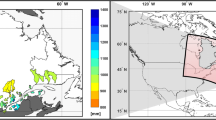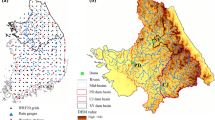Abstract
Our study focuses on the hydrologic implications of resolving and modeling atmospheric processes at different spatial scales. Here we use heavy precipitation events from an atmospheric model that was run at different horizontal grid spacings (i.e., 250 m, 500 m, 1 km, 2 km 4 km, and 12 km) and able to resolve different processes. Within an idealized simulation framework, these rainfall events are used as input to an operational distributed hydrologic model to evaluate the sensitivity of the hydrologic response to different forcing grid spacings. We consider the finest scale (i.e., 250 m) as reference, and compute event peak flows and volumes across a wide range of basin sizes. We find that the use of increasingly-coarser inputs leads to changes in the distribution of event peak flows and volumes, with the strongest sensitivity at the smallest catchment sizes. Our results show the compromise between computational cost and hydrologic performance, providing basic information for future endeavors geared towards regional downscaling.




Similar content being viewed by others
Availability of data and material
The hydrologic simulations that support the findings of this study are available from the corresponding author upon reasonable request.
Code Availability
Custom codes that support the statistical modeling results are available from the corresponding author upon request.
References
Ayalew TB, Krajewski WF, Mantilla R, Small SJ (2014) Exploring the effects of hillslope-channel link dynamics and excess rainfall properties on the scaling structure of peak-discharge. Adv Water Resour 64:9–20. https://doi.org/10.1016/j.advwatres.2013.11.010
Bennett B, Leonard M, Deng Y, Westra S (2018) An empirical investigation into the effect of antecedent precipitation on flood volume. J Hydrol 567:435–445. https://doi.org/10.1016/j.jhydrol.2018.10.025
Berghuijs WR, Harrigan S, Molnar P et al (2019) The Relative Importance of Different Flood-Generating Mechanisms Across Europe. Wiley Online Libr 55:4582–4593. https://doi.org/10.1029/2019WR024841
Bryan GH, Morrison H (2012) Sensitivity of a simulated squall line to horizontal resolution and parameterization of microphysics. Mon Weather Rev 140:202–225. https://doi.org/10.1175/MWR-D-11-00046.1
Clark P, Roberts N, Lean H et al (2016) Convection-permitting models: A step-change in rainfall forecasting. Meteorol Appl 23:165–181
Dankers R, Christensen OB, Feyen L et al (2007) Evaluation of very high-resolution climate model data for simulating flood hazards in the Upper Danube Basin. J Hydrol 347:319–331. https://doi.org/10.1016/j.jhydrol.2007.09.055
Fang X, Pomeroy JW (2016) Impact of antecedent conditions on simulations of a flood in a mountain headwater basin. Wiley Online Libr 30:2754–2772. https://doi.org/10.1002/hyp.10910
Fowler HJ, Lenderink G, Prein AF et al (2021) Anthropogenic intensification of short-duration rainfall extremes. Nat Rev Earth Environ 2(2):107–122. https://doi.org/10.1038/s43017-020-00128-6
Graham LP, Andreáasson J, Carlsson B (2007) Assessing climate change impacts on hydrology from an ensemble of regional climate models, model scales and linking methods - A case study on the Lule River basin. Clim Change 81:293–307. https://doi.org/10.1007/s10584-006-9215-2
Grimley LE, Quintero F, Krajewski WF (2020) Streamflow predictions in a small urban-rural watershed: The effects of radar rainfall resolution and urban rainfall-runoff dynamics. Atmos (Basel) 11:774. https://doi.org/10.3390/ATMOS11080774
Kendon EJ, Prein AF, Senior CA, Stirling A (2021) Challenges and outlook for convection-permitting climate modelling. Philos Trans R Soc A Math Phys Eng Sci 379(2195). https://doi.org/10.1098/rsta.2019.0547
Lebo ZJ, Morrison H (2015) Effects of horizontal and vertical grid spacing on mixing in simulated squall lines and implications for convective strength and structure. Mon Weather Rev 143:4355–4375. https://doi.org/10.1175/MWR-D-15-0154.1
Maina FZ, Siirila-Woodburn ER, Vahmani P (2020) Sensitivity of meteorological-forcing resolution on hydrologic variables. Hydrol Earth Syst Sci 24:3451–3474. https://doi.org/10.5194/hess-24-3451-2020
Mendoza PA, Mizukami N, Ikeda K et al (2016) Effects of different regional climate model resolution and forcing scales on projected hydrologic changes. J Hydrol 541:1003–1019. https://doi.org/10.1016/j.jhydrol.2016.08.010
Olsson J, Berg P, Kawamura A (2015) Impact of RCM spatial resolution on the reproduction of local, subdaily precipitation. J Hydrometeorol 16:534–547. https://doi.org/10.1175/JHM-D-14-0007.1
Powers JG, Klemp JB, Skamarock WC et al (2017) The weather research and forecasting model: Overview, system efforts, and future directions. Bull Am Meteorol Soc 98:1717–1737. https://doi.org/10.1175/BAMS-D-15-00308.1
Prein AF, Holland GJ, Rasmussen RM et al (2013) Importance of regional climate model grid spacing for the simulation of heavy precipitation in the colorado headwaters. J Clim 26:4848–4857. https://doi.org/10.1175/JCLI-D-12-00727.1
Prein AF, Langhans W, Fosser G et al (2015) A review on regional convection-permitting climate modeling: Demonstrations, prospects, and challenges. Rev Geophys 53:323–361
Prein AF, Rasmussen RM, Wang D, Giangrande SE (2021) Sensitivity of organized convective storms to model grid spacing in current and future climates. Philos Trans R Soc A Math Phys Eng Sci 379(2195). https://doi.org/10.1098/rsta.2019.0546
Quintero F, Sempere-Torres D, Berenguer M, Baltas E (2012) A scenario-incorporating analysis of the propagation of uncertainty to flash flood simulations. J Hydrol 460–461:90–102. https://doi.org/10.1016/j.jhydrol.2012.06.045
Quintero F, Krajewski WF (2018) Mapping Outlets of Iowa Flood Center and National Water Center River Networks for Hydrologic Model Comparison. J Am Water Resour Assoc 54:28–39. https://doi.org/10.1111/1752-1688.12554
Quintero F, Krajewski WF, Seo BC, Mantilla R (2020) Improvement and evaluation of the Iowa Flood Center Hillslope Link Model (HLM) by calibration-free approach. J Hydrol 584:124686. ISSN 0022-1694. https://doi.org/10.1016/j.jhydrol.2020.124686
Rasmussen R, Liu C, Ikeda K et al (2011) High-resolution coupled climate runoff simulations of seasonal snowfall over Colorado: A process study of current and warmer climate. J Clim 24:3015–3048. https://doi.org/10.1175/2010JCLI3985.1
Rasmussen R, Ikeda K, Liu C et al (2014) Climate change impacts on the water balance of the Colorado headwaters: High-resolution regional climate model simulations. J Hydrometeorol 15:1091–1116. https://doi.org/10.1175/JHM-D-13-0118.1
Skamarock WC, Klemp JB (2008) A time-split nonhydrostatic atmospheric model for weather research and forecasting applications. J Comput Phys 227:3465–3485. https://doi.org/10.1016/j.jcp.2007.01.037
van Roosmalen L, Christensen JH, Butts MB et al (2010) An intercomparison of regional climate model data for hydrological impact studies in Denmark. J Hydrol 380:406–419. https://doi.org/10.1016/j.jhydrol.2009.11.014
Wang D, Giangrande SE, Feng Z et al (2020) Updraft and Downdraft Core Size and Intensity as Revealed by Radar Wind Profilers: MCS Observations and Idealized Model Comparisons. J Geophys Res Atmos 125:e2019JD031774. https://doi.org/10.1029/2019JD031774
Acknowledgements
This work was supported in part by the Iowa Department of Transportation (Project number 20-SPR2-002). The opinions, findings, and conclusions expressed in this publication are those of the author and not necessarily those of the Iowa Department of Transportation or the United States Department of Transportation, Federal Highway Administration. Support by the Iowa Flood Center, IIHR—Hydroscience & Engineering, and the U.S. Army Corps of Engineers’ Institute for Water Resources is gratefully acknowledged. NCAR is partly funded by the National Science Foundation under Cooperative Agreement No. 1852977. The suggestions by two anonymous reviewers are gratefully acknowledged.
Funding
This work was supported in part by the Iowa Department of Transportation (Project number 20-SPR2-002). NCAR is partly funded by the National Science Foundation under Cooperative Agreement No. 1852977.
Conflicts of interest/Competing interestsNothing to declare.
Author information
Authors and Affiliations
Contributions
FQ, GV, and AP designed the experiments; FQ and AP performed the analyses. All authors interpreted the results and wrote the paper.
Corresponding author
Ethics declarations
Additional declarations for articles in life science journals that report the results of studies involving humans and/or animals
Not applicable’ for that section.
Ethics approval
Nothing to declare.
Consent to participate
Nothing to declare.
Consent for publication
Nothing to declare.
Additional information
Publisher’s Note
Springer Nature remains neutral with regard to jurisdictional claims in published maps and institutional affiliations.
Rights and permissions
About this article
Cite this article
Quintero, F., Villarini, G., Prein, A.F. et al. On the role of atmospheric simulations horizontal grid spacing for flood modeling. Clim Dyn 59, 3167–3174 (2022). https://doi.org/10.1007/s00382-022-06233-0
Received:
Accepted:
Published:
Issue Date:
DOI: https://doi.org/10.1007/s00382-022-06233-0




